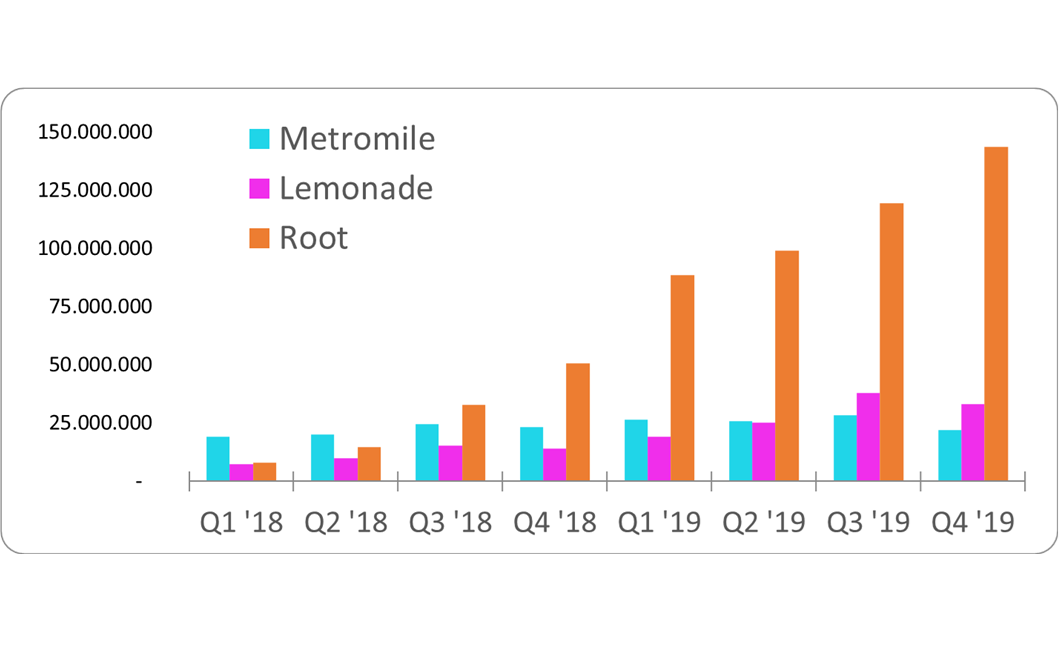
Since the first “Five Dispatches from InsurTech Survival Island”, Matteo has partnered with Adrian and in recent months with Sri, to analyze quarterly statutory statements of the most relevant US P&C full-stack InsurTech carriers. The principal goal has been to influence the dialog, debate and deliberations in the InsurTech space debate, and to promote a fact-based perspective to the discussion. Even as we continue to write about the future of insurance, about a year ago, Matteo declared his love for “old insurance KPIs” in this widely read article. While futurologists distanced from assessing P&L statements might disagree, many readers have liked the usage and explanation of insurance KPIs in the context of innovation. We are pleased to see more industry experts and authors join us in crunching numbers, assessing issues and taking a fact-based view on insurance innovation. We were especially pleased to see even some executives of InsurTech startups talk about core KPIs in the context of their innovative business models. So, we entered 2020 with a belief we had accomplished our mission to spark a P&L, fact-based dialog in the insurance innovation space.
Surprisingly, neither Q3 ‘19 nor Q4 ’19 financials got any attention from analysts, and some friends pinged us suggesting we continue the series for the foreseeable future. We hear you loud and clear, and we will continue to publish these digests based on assessing the fundamentals of the InsurTech players in the context of the broader insurance industry. We are back!
Our journey continues here today. We are back with an analysis of the InsurTech trio’s financial performances, and to share our humble assessment of the competitive posture and advantage for these three innovative insurance start-ups.

Key Financials
Let’s start as we typically do, with a look at the core financials. Frequent readers might recall our snapshot view that lists the core financial metrics for the three InsurTech players. As you read this summary, we would like to remind you again that we do not comment on the cost side of the equation and we suggest our readers not believe in them because of the “goals seek triumph” issue Matteo discusses in this article from last year.
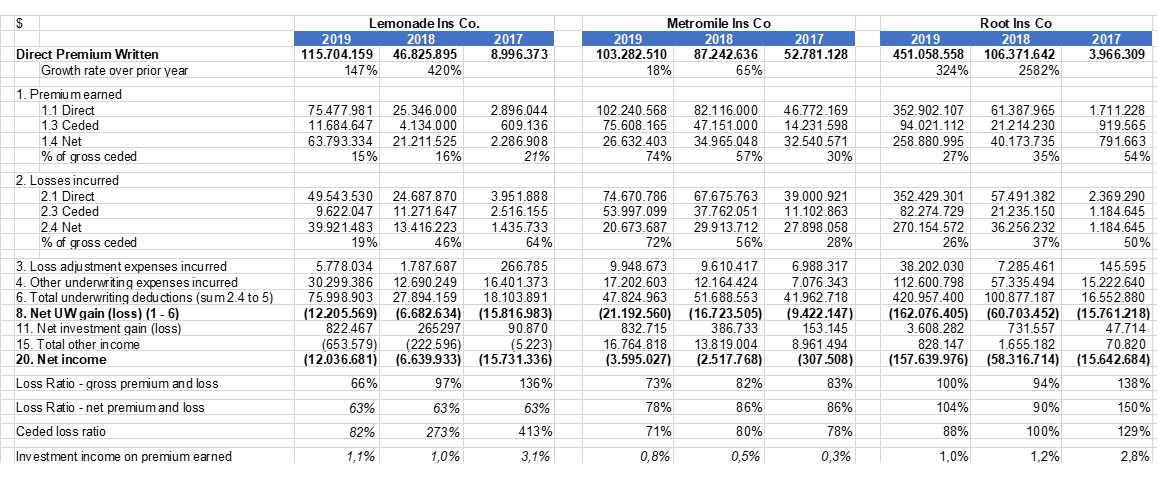
Observations:
“To each his own”. This phrase probably sums up best how we view the distinction between the three InsurTech players Lemonade, Root, and Metromile. We see the three players take three different paths to customer relevance and financial performance:
- Metromile: An auto insurer with a modest growth and has only partially closed the profitability gap with the market (73% loss ratio vs 64% market average). This, to us, does not seem the story you would expect from a startup in the growth phase.
- Lemonade: A home insurance company that has improved the technical sustainability of their business partially closing the profitability gap with the market (66% vs 58% of the market) and showing a promising trajectory of improvement. However, it has sacrificed along this journey the expectations many had for this “market disruptor”. The $480M funding venture has created a book of business that still accounts for just 0.1% for the US homeowner insurance market. This $115M revenue milestone is really a far cry from the “massive disruption effect” which was expected during their debut.
- Root: An auto insurer that continues its journey of exponential growth (their portfolio is three times bigger at the end of 2019 than it was at the end of 2018) but are paying in claims the same amount collected as premium. They appear to be using the $350M Series E funding from DST Global and Coatue in August 2019 to cover their expenses. This company too accounts for less than 0.2% of the auto insurance market.
Let’s take a closer look at the loss ratios:
- Metromile’s loss ratio has been stable in the lower 70’s for all of 2019. They started selling their claims tools to other insurers but the performances on their own book do not tell a great story for this new business. More broadly, the usage of telematics data on claim processing has shown potential to reduce the loss ratio at an international level. If an insurer has to choose a provider for telematics-based claims, it makes more sense to use one that has achieved results in doing it. A carrier would probably feel more comfortable to use something like the G-evolution services that have already provided competitive advantages on Groupama Italy’s auto portfolio.
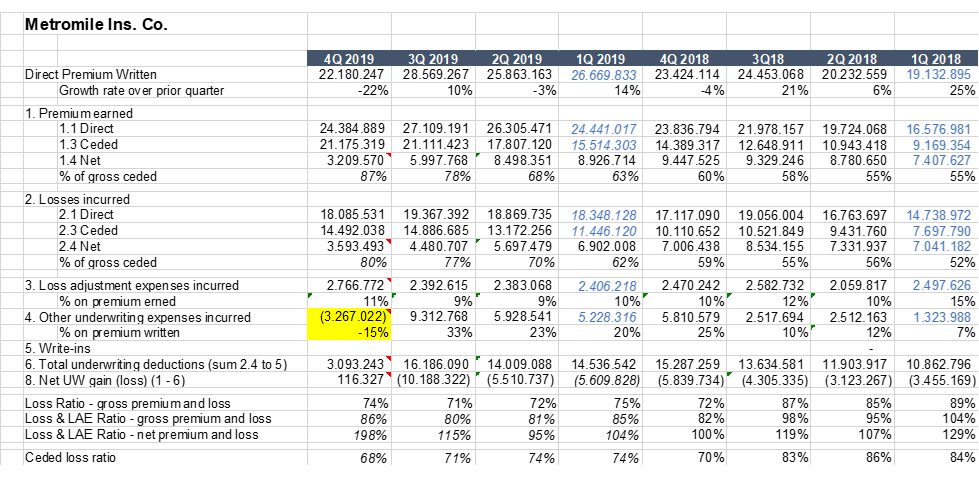
- Root ended the year 2019 with a 100% loss ratio, paying out in claims effectively an amount equivalent to the premiums received. While Q4 '19 saw a loss ratio at 93% compared to 113% in the prior quarter, and 91% in the second quarter. The technical profitability has not yet shown a consistent improvement in the right direction. However, it is interesting to see how the loss ratios are fairly consistent in the core lines of business: auto liability and auto physical damage. Instead in 2018, auto liability showed a loss ratio not too far from the market average instead physical damage showed a terrible loss ratio above 120%. They are smart guys and we believe they are deliberately underpricing the risks to attract customers. Theoretically, telematics could allow them to improve their loss ratio through behavioral change and the use of data in claims processing to anticipate the FNOL and enhance the effectiveness of the claim handling processes. It seems they have still ignored this potential, instead focusing only on a few weeks of monitoring, but these strategic options seem achievable in the future.
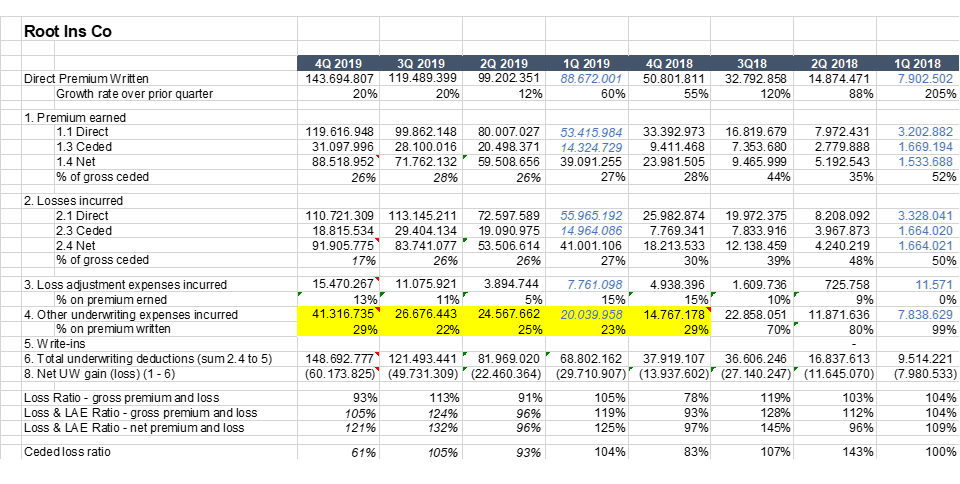
- Lemonade has been on a trajectory of improving their loss ratios over the last few quarters. They have had a consistent decline (i.e. improvement) in their loss-ratios. From a loss-ratio of 88% in Q4 ‘18 to a loss-ratio of 61% in Q4 ‘19, their loss-ratios have always improved. Lemonade celebrated their use of advanced AI powered fraud detection in ensuring "bad risks” are caught, assessed and filtered out. Looking to the slowdown of their growth which we address in the next paragraph, an increase of the pricing seems to be the main driver of this technical profitability recovery.
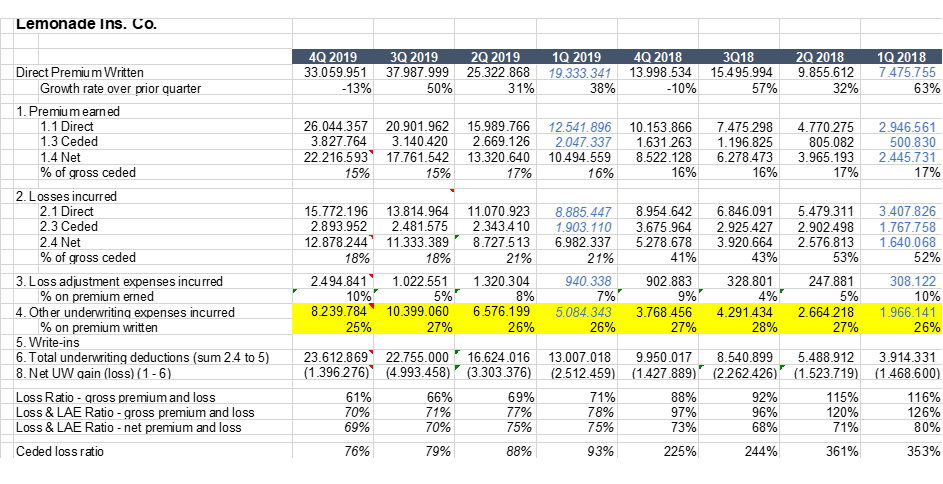
In the last article we highlighted the “pricing war”. So, let’s take a closer look at the top-line generated by these different approaches to the reach a sustainable loss ratio:
- Root’s quarter over quarter growth rate appears to have “settled” at around 20%, which is lower than their past performances. Looking back over a 2-year horizon, 2019's quarter of quarter growth rate seems rather sedate compared to the 2018 quarterly growth rates. However, in absolute numbers, this mean that in the last quarters they have increased their written premium by $20M (from $99M to $119M) and $24M (from $119M to $144M). These represent their third and second best quarterly growths, after the record of $38M increase achieved in Q1 ’19 (from $51M to $89M). With Root now available to more than 65% of the US driving population (‘18 new states contributed for 29% of the ‘19 growth, and ‘19 states for another 17%), it remains to be seen how they can continue to capture customers switching for cheaper price. Root has also started to cross sell their customer base with renter insurance. This business line has contributed for K229$ to the top line.
- Lemonade's growth has slowed down: Lemonade's quarterly growth compared with the same period of the previous year has reduced. With healthy growth quarter over quarter from Q1 ‘19 through Q3 ‘19, we see a reversal in Q4 ‘19. The 13% reduction in Q4 ‘19 was worse than the 10% reduction between Q4 ‘18 and Q3 ‘18. One year ago, they said we “messed-up an entire quarter” because premium growth turned negative, when in fact the company generated their best quarterly loss ratio ever (it has happened again!).
- Metromile underwritten premiums grow only by $3M in Q3 ‘19 (compared with Q2 ‘19) and in Q4 ’19 had, in absolute numbers, their worst quarter since Q3 ’18. This to us is a clear sign that their product likely attracts only users who drive infrequently or never drive.
Cost Position
We are also not able to compare their real costs. As we discussed earlier, the companies are not reporting all of their costs in the yellow book anymore and therefore true cost positions cannot be judged. As an example, Metromile's stated underwriting expenses in the 4th quarter of the year went down, similar to movement we saw in the 4th quarter of 2017.
Our humble opinion
Let’s be frank. From these figures only Root is showing the trajectory expected for a startup in the growth phase. Even with gaps on the technical sustainability of their portfolio, they have a profitability improvement opportunity driven by better usage of telematics data. If the team builds mastery in usage of telematics data for behavior change and claims management, this venture could find the “root” for a sustainable growth. With this focus and strategy, they really wouldn’t need to invent anything fundamentally new and different. There are best practices on behavior change and claims management they can emulate from players like Allstate (USA) and Discovery Insure (South Africa), and UnipolSai and Groupama (Italy) respectively.
Continuing on the telematics topic, Metromile’s equity story seem less exciting. Customer appeal towards pay-per-use continues to be limited at best. Uncertainty of a fluctuating premium over the period of coverage is a barrier for the adoption. This model is attracting only customers who drive infrequently and focus on saving on their insurance premium costs.
The long tail of excitement with the disruption buzzword continues to characterize Lemonade’s march in this trio. The charity giveback - that has fascinated many commentators over the past years and Matteo described in detail in one past article with Steve Anderson - accounted at K632$ (1,3% of the 2018 premiums) last year and K162$ (1,8% of the 2017 premiums), i.e. a pretty inexpensive public relations and marketing tool. On a different note, their forward-looking plans to cross-sell and offer pet insurance appears to be a well thought out move that fits with the equity story for a start-up at their stage. Finally, their expansion into the German market generating K100€ premiums in 2019 appears to be another checkmark on the “to do list” of the “perfect startup”. Net-net, Lemonade’s story appears to excite industry commentators more than it excites customers! On this note, there appears to be no sign of disruption in the homeowner insurance sector. Matteo has already earned the title of “cynic” from the Lemonade founder for a similar statement Matteo made a year ago.
Looking ahead now, what paths will each of these InsurTechs take, and how will they get there? Will Covid-19 change everything?
Another question on everyone’s mind is probably this: What will be the impact of temporary lookdowns on the three players? As we look ahead into expected results from Q1-2020, we expect to see the effect of Covid-19 play out in a few different ways.
- We expect Metromile to be the most impacted due to the fact that their product is based on a "per mile" computation basis. Analysts are already reporting that mid-March to the end of the April, "miles driven" have reduced by 50%. With millions of US residents that have spent a couple of months in lockdown, we expect the Metromile top line will shrink in Q1 ’19.The company has already laid off part of the employees, including the entire marketing team.
- Root has announced a "stay at home" bonus similar to many other auto insurance carriers. Root's incentives are based on a measured 20% or more reduction in driving in April and May. With the lockdown, their try-before-you-buy approach probably takes more time to be completed so their growth will be impacted.
- We do not currently expect any change in the coverage needs and or customer behavior for the core products that Lemonade provides. We do however expect that macro-economic issues like increasing unemployment, underemployment and reduction in disposable incomes will lead on one side to some customers seeking lower prices through competitive shopping but, on the other hand, customers who have never considered or bought renters insurance policies may continue to ignore the need and shun the product. Industry watchers will recall Lemonade’s claim on effectively attracting first time buyers of rental insurance. We expect this to be tested.
From a broader P&L perspective, we also expect to see Q1 ’20 investment income to be depressed.
Looking ahead to the rest of the year from his exile in a downtown Atlanta hotel, Matteo has already articulated his thoughts about futurologists who are designing a future based on their own self-image over the past few weeks (note: there have been tons of articles and webinars claiming that “nothing will be as before” and announcing the triumph of both digital distribution channels and pay-per-use telematics ). Matteo is skeptical about any long terms structural changes brought about by a few weeks of lockdown. Sri on the other hand believes that while the “target state” of consumer behavior and expectations may not be known for a while, the Covid-19 crisis will cause at least some segments of consumers to fundamentally rethink their risk management and insurance solution needs. He also expects changes in sectors like commercial real estate to push commercial insurance companies to rethink products, pricing and positioning in the commercial sector.
*****
As we sign off this quarterly dispatch, many US states are currently reopening their economy – as European countries are progressively doing - We hope to be back soon to discussing insurance innovation on the stage of a big conference and to never have to comment again on the impact of a “lockdown”!



